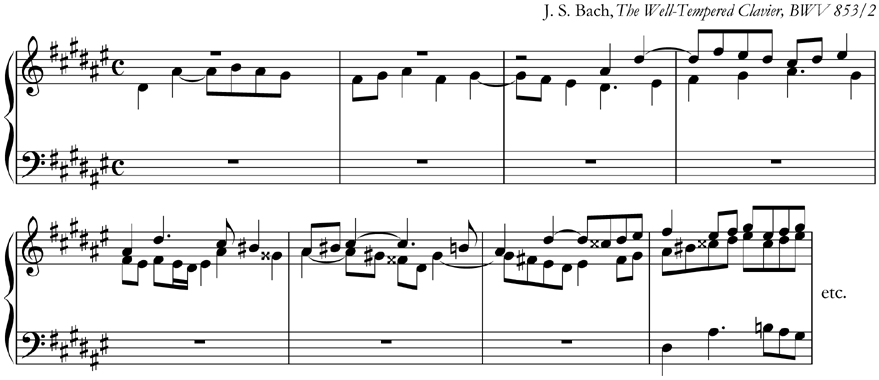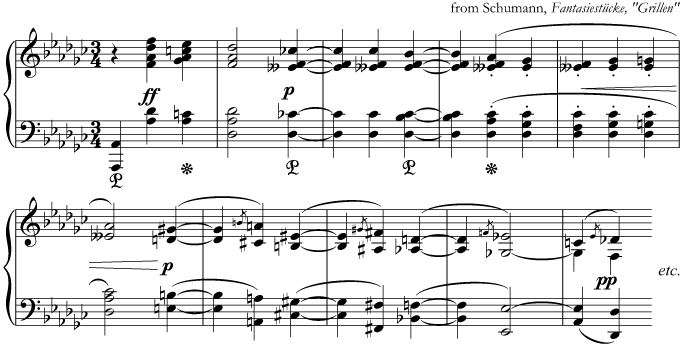Double sharps and flats
In this guide...
Key terms:
Subscription required!
To view the complete study guide, you will need a valid subscription. Why not subscribe now?
Already have a subscription? Make sure you login first!
Introduction
You will be familiar by now with flats, naturals, and sharps, their use in key signatures and as accidentals, and how to cancel them. Now we will look at some special accidentals: double flats and sharps.
A reminder
It is worth being sure, before we start, that you are clear on the use of flats, sharps, and naturals:
#1: In key signatures
The most common place to find the flat and sharp symbols is in the key signature. For example, the key signature of G major has one sharp (an F sharp). The sharps and flats appear in a specific order in the key signature.
Here are the correct positions of the sharps and flats in each of the four clefs:
 Location of sharps and flats in the key signature in different clefs
Location of sharps and flats in the key signature in different clefsNote, however, that you never find a natural sign in the key signature!
#2: To alter the effect of the key signature
Flats, sharps, and also natural signs can be used to alter the effect of a key signature. In this use, these signs are called accidentals.
For example, if we are in a minor key, we will need to use accidentals for the 6th and 7th degrees of the scale. Here is a short tune in G minor which does exactly this:
 A short tune in G minor that uses accidentals
A short tune in G minor that uses accidentals#3: To cancel previous accidentals
Having used a flat, sharp, or natural to alter the effect of the key signature, you will need to use an accidental again to go back to the key signature - unless a barline comes along first to do the job for you! This is called cancellation.
Here is a short example that does this:
 Cancellation of accidentals before the barline in Mozart's The Marriage of Figaro
Cancellation of accidentals before the barline in Mozart's The Marriage of Figaro#4: As a reminder
After having used an accidental to alter the effect of a key signature, the next barline will cancel this effect. It's common to use an accidental, anyway, to remind the player to obey the key signature and forget about the previous accidental.
In this case, the accidental will be the same as that in the key signature, and this kind of accidental - that does nothing except remind the player - is called a cautionary accidental.
Double sharps
Now that we're clear on the different uses of accidentals, let's meet a completely new accidental: the double sharp.
A sharp raises a note by one semitone. Double sharps, on the other hand, raise a note by two semitones. Here is the symbol for a double sharp - it doesn't look anything like a normal sharp sign: ![]()
Double sharps are not needed very often, and so you seldom encounter them. You will usually find them in minor keys with large numbers of sharps, primarily in the scale of G sharp minor, which has an F double sharp, and D sharp minor which has a C double sharp.
You may also see them in musical extracts, and be asked to give the correct enharmonic equivalent - which is simply the note that is two semitones higher than the natural version of the note written.
Don't be tempted to think that an F double sharp, for example, is in fact a G. It sounds the same as a G, and the enharmonic equivalent is G, but F double sharp is still an F!
This fact is of great importance when you have to describe an interval. For more about this, see Intervals level 5.
Uses of double sharps
Of the uses listed above, some do not apply to double sharps at all:
#1: In key signatures
You will never find double sharps in key signatures - they will only ever appear as accidentals. This is because the possible key signatures that could use double sharps are so obscure that no-one ever uses them. For example, G sharp major would have eight sharps, the eighth of which would be F double sharp. However music in this key would be hard to read, and much easier in the enharmonically equivalent A flat major, with only 4 flats!
#2: To alter the effect of the key signature
This is the main use of double sharps, and is very common if the music is in a minor key such as G sharp minor or D sharp minor.
In this case, the double sharp sign is used exactly as a normal sharp sign would be used.
#3: To cancel previous accidentals
While a double sharp would never be used to cancel a previous accidental (for the simple reason that double sharps are never found in key signatures!), you will often need to cancel the effect of a double sharp.
This is done either with a natural sign (to return to an F natural from an F double sharp, for example), or with a single sharp sign (to return to F sharp from F double sharp).
#4: As a reminder
Again, as double sharps are never found in the key signature, you will never need to use them as a reminder of the key signature.
An example using double sharps
Here is the opening of a fugue by J. S. Bach in the unusual key of D sharp minor. Note the use of accidentals and double sharps, and look for the cautionary accidentals after barlines. Note also how after a double sharp accidental is cancelled by a barline, the cautionary accidental is a single sharp.
 Music by J.S. Bach in D sharp minor
Music by J.S. Bach in D sharp minorDouble flats
As with sharps and double sharps, there also exists a double flat, with this symbol: ![]()
Predictably, a double flat means that a note is lowered by two semitones - double the effect of a normal flat. You will come across double flats even less often than double sharps, as there are no common keys or scales that use double flats.
A typical use of a double flat is when the music temporarily modulates (i.e. changes key for a few bars) to an obscure key such as F flat major (which needs a B double flat).
Modulating to F flat major might seem a strange thing to do, but it is more common that you might think!
A common modulation is "to the dominant" or "up a semitone". If you are already in C flat major, you'll need F flat major for the dominant key; and (perhaps more likely), if you are in E flat major, you'll need F flat major if you modulate up a semitone.
Uses of double flats
As double flats are not used in any key signature, they are used in just the same way as double flats. The main concern, then, is cancellation of a double flat. This is done just as with double sharps - either by using a single flat or natural sign to return to the correct note as specified by the key signature.
An example using double flats
Here is an example for the piano, by Schumann, which uses double flats. In this case, he started in G flat major (hence the key signature of 6 flats), and modulated in to the dominant - D flat major - where the extract begins. From there the music modulates into A major. In order to do this he goes through a sequence of chords which are not in any particular key, to set up an enharmonic in order to prepare a perfect cadence onto an A major chord. Phew!
 from Phantasiestücke - Grillen, Schumann
from Phantasiestücke - Grillen, SchumannUsing enharmonic equivalents
Note how in bar 6 the A flat becomes an G sharp, the E double flat becomes a D natural, and the C flat becomes a B natural: three enharmonic shifts at once!
The reason Schumann uses these enharmonic shifts is to avoid having to write in F flat major (instead of E major), and then having to write a B double flat major chord instead of the A major chord you can see in bar 7.
The F sharp major chord you can see in bar 8 could easily be written as a G flat major chord - which would reflect the key signature - and the chord before it could have been written as D flat dominant 7th instead of C sharp dominant 7th.
Schumann has ventured into sharps here simply to avoid writing chords of F flat major and B double flat major - which should give you an idea of just how little they are used!
Here is the same music (from the 6th bar only), re-written without the enharmonic shift to sharps. This version is probably harder to play, however:
 from Phantasiestücke - Grillen, Schumann, without enharmonic shifts
from Phantasiestücke - Grillen, Schumann, without enharmonic shiftsNote the use of a cautionary F natural in the 2nd bar and cautionary B flats in the 3rd bar of this revised version, in both staves, to remind the player no longer to play F flats and B double flats!
Read more...
With a subscription to Clements Theory you'll be able to read this and dozens of other study guides, along with thousands of practice questions and more! Why not subscribe now?
Revision
Are you sure you've understood everything in this study guide? Why not try the following practice questions, just to be sure!